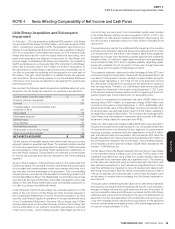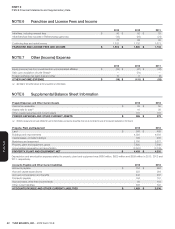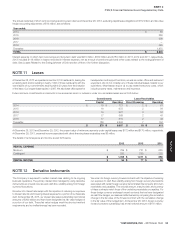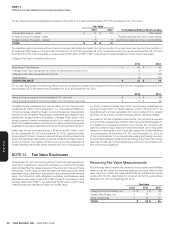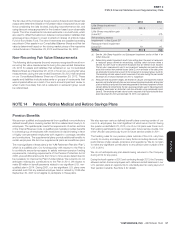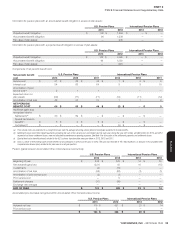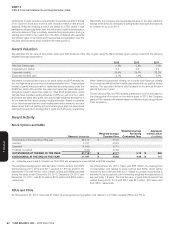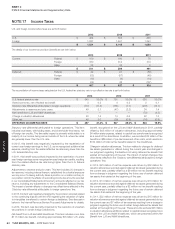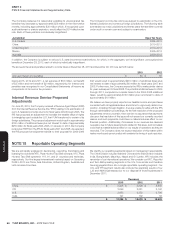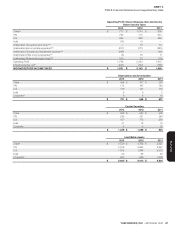Pizza Hut 2013 Annual Report Download - page 153
Download and view the complete annual report
Please find page 153 of the 2013 Pizza Hut annual report below. You can navigate through the pages in the report by either clicking on the pages listed below, or by using the keyword search tool below to find specific information within the annual report.
YUM! BRANDS, INC.-2013 Form10-K 57
Form 10-K
PART II
ITEM 8Financial Statements andSupplementaryData
The fair value of the Company’s foreign currency forwards and interest rate
swaps were determined based on the present value of expected future cash
flows considering the risks involved, including nonperformance risk, and
using discount rates appropriate for the duration based upon observable
inputs� The other investments include investments in mutual funds, which
are used to offset fluctuations in deferred compensation liabilities that
employees have chosen to invest in phantom shares of a Stock Index
Fund or Bond Index Fund� The other investments are classified as trading
securities in Other assets in our Consolidated Balance Sheets and their fair
value is determined based on the closing market prices of the respective
mutual funds as of December 28, 2013 and December 29, 2012.
Non-Recurring Fair Value Measurements
The following table presents (income) expense recognized from all non-
recurring fair value measurements during the year ended December
28, 2013 for assets and liabilities that remained on our Consolidated
Balance Sheet as of December 28, 2013 or for all non-recurring fair value
measurements during the year ended December 29, 2012 that remained
on our Consolidated Balance Sheet as of December 29, 2012. These
assets and liabilities include restaurants or groups of restaurants that
were impaired either as a result of our semi-annual impairment review or
when it was more likely than not a restaurant or restaurant group would
be refranchised.
2013 2012
Little Sheep impairment
(Level 3)(a) $ 295 $ —
Little Sheep acquisition gain
(Level 2)(a) — (74)
Refranchising related
impairment – other (Level 3)(b) — 4
Restaurant-level impairment
(Level 3)(c) 19 16
TOTAL $ 314 $ (54)
(a) See the Little Sheep Acquisition and Subsequent Impairment section of Note 4 for
further discussion.
(b) Refranchising related impairment results from writing down the assets of restaurants
or restaurant groups offered for refranchising, including certain instances where a
decision has been made to refranchise restaurants that are deemed to be impaired.
The fair value measurements used in our impairment evaluation are based on either
actual bids received from potential buyers (Level 2), or on estimates of the sales prices
we anticipated receiving from a buyer for the restaurant or restaurant groups (Level 3).
The remaining net book value of assets measured at fair value during the years ended
December 28, 2013 and December 29, 2012 is insignificant.
(c) Restaurant-level impairment charges are recorded in Closures and impairment (income)
expenses and resulted primarily from our semi-annual impairment evaluation of long-lived
assets of individual restaurants that were being operated at the time of impairment and had
not been offered for refranchising. The fair value measurements used in these impairment
evaluations were based on discounted cash flow estimates using unobservable inputs
(Level 3). The remaining net book value of assets measured at fair value during the years
ended December 28, 2013 and December 29, 2012 is not significant.
NOTE14 Pension, Retiree Medical and Retiree Savings Plans
Pension Benefits
We sponsor qualified and supplemental (non-qualified) noncontributory
defined benefit plans covering certain full-time salaried and hourly U.S.
employees. The qualified plan meets the requirements of certain sections
of the Internal Revenue Code. A qualified plan typically provides benefits
to a broad group of employees with restrictions on discriminating in favor
of highly compensated employees with regard to coverage, benefits
and contributions. The supplemental plans provide additional benefits to
certain employees. We fund our supplemental plans as benefits are paid.
The most significant of these plans is the YUM Retirement Plan (the “Plan”),
which is a qualified plan. Our funding policy with respect to the Plan is
to contribute amounts necessary to satisfy minimum pension funding
requirements, including requirements of the Pension Protection Act of
2006, plus additional amounts from time to time as are determined to
be necessary to improve the Plan’s funded status. We currently do not
anticipate making any contributions to the Plan in 2014. We expect to
make $8 million in benefit payments related to our significant U.S. non-
qualified plan in 2014. During 2001, our two significant U.S. plans were
amended such that any salaried employee hired or rehired by YUM after
September 30, 2001 is not eligible to participate in those plans.
We also sponsor various defined benefit plans covering certain of our
non-U.S. employees, the most significant of which are in the UK. During
the quarter ended March 23, 2013, one of our UK plans was frozen such
that existing participants can no longer earn future service credits. Our
other UK plan was previously frozen to future service credits in 2011.
The funding rules for our pension plans outside of the U.S. vary from
country to country and depend on many factors including discount rates,
performance of plan assets, local laws and regulations. We do not plan
to make any significant contributions to any pension plan outside of the
U.S. in 2014.
We do not anticipate any plan assets being returned to the Company
during 2014 for any plans.
During the fourth quarter of 2012 and continuing through 2013, the Company
allowed certain former employees with deferred vested balances in our
U.S. pension plans an opportunity to voluntarily elect an early payout of
their pension benefits. See Note 4 for details.




